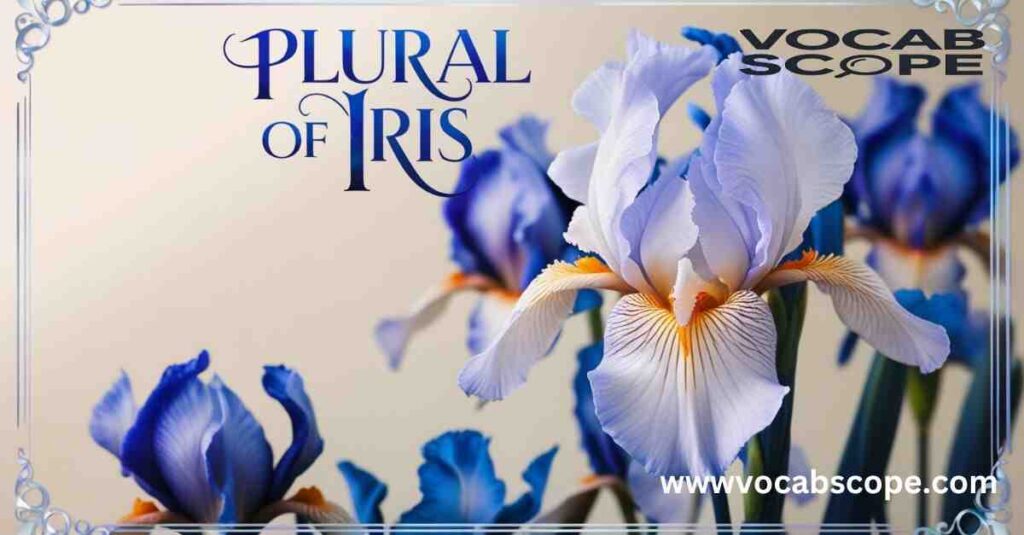Understanding plural forms in English can be tricky, especially with words that have Latin or Greek origins. One such word is “iris”, which can refer to either the flower or the colored part of the eye. What makes it more complicated is that “iris” has two plural forms—irises and irides. The plural form you use depends on the context you’re speaking about, and each has its own distinct usage.
In this article, we’ll dive deep into the plural of iris, explore the rules that govern its pluralization, and provide clear examples to help you understand when to use each form. By the end, you’ll feel confident in knowing which plural to use—whether you’re discussing botany or anatomy!
What is the Plural of Iris?
When forming the plural of “iris,” English gives us two options: irises and irides. Both are correct, but they’re used in different contexts.
- Irises: The more common plural form in modern English, used when referring to the iris flowers or multiple parts of the eye.
- Irides: A rarer, more formal plural that comes from the Latin word “iridēs,” typically used in anatomical or scientific contexts to describe the colored part of the eye.
To summarize:
- When talking about multiple flowers or referring casually to eyes, you use irises.
- In a more scientific context, especially when discussing the anatomy of the eye, you might use irides.
Why Are the Plurals ‘Irises’ and ‘Irides’?
The dual plurals of “iris” stem from its rich linguistic history and varied usage. Here’s the scoop:
- Irises: This plural follows the standard English rule of adding “-es” to words ending in “-is”. It’s the go-to plural for most everyday situations, especially when referring to the flower.
- Irides: This plural comes from the word’s Latin and Greek roots. It’s more often used in scientific or medical contexts, particularly when referring to the part of the eye.
Let’s look at it this way:
| Plural Form | Primary Usage | Context |
| Irises | General, Botanical | Everyday language, gardening |
| Irides | Scientific, Anatomical | Medical literature, academic writing |
What is an Iris?
Before we delve deeper into plurals, let’s clarify what an “iris” actually is. This word refers to two main things:

- Iris as a Flower: The iris is a showy, colorful flowering plant that belongs to the Iridaceae family. It’s known for its vibrant petals and wide range of colors, often blooming in spring and early summer.

- Iris as a Part of the Eye: In anatomy, the iris is the colored ring of tissue that surrounds the pupil in the eye. It helps control the amount of light entering the eye and determines your eye color based on genetics.
Given that iris has these dual meanings, it’s important to know which plural form to use depending on whether you’re discussing flowers or eye anatomy.
Using ‘Iris’ in Sentences (Singular Usage)
Let’s see this versatile word in action with some singular usage examples:
- The vibrant purple iris caught everyone’s attention in the garden.
- Dr. Smith examined the patient’s iris for signs of inflammation.
- An iris scan is a highly secure form of biometric identification.
- The photographer captured a stunning close-up of a single iris petal.
- My grandmother’s favorite flower is the bearded iris.
- The artist painted a detailed iris in various shades of blue.
- The iris diaphragm in the camera lens controls the amount of light entering.
- A rare white iris bloomed in our backyard this spring.
- The optometrist noted an unusual pattern in the patient’s iris.
- The florist carefully arranged a single iris as the centerpiece of the bouquet.
Using ‘Irises’ and ‘Irides’ in Sentences (Plural Usage)
Now, let’s explore how to use both plural forms correctly:
Usage of “Irises”:
- The garden was abloom with colorful irises of every hue imaginable.
- Botanists have identified over 300 species of irises worldwide.
- Dutch irises are known for their early spring blooms.
- The florist arranged a bouquet of purple and yellow irises.
- Bearded irises are popular among gardeners for their striking appearance.
- The artist’s latest series featured close-up paintings of irises.
- Siberian irises are known for their ability to thrive in wet conditions.
- The bride chose blue irises for her wedding bouquet.
- Japanese irises typically bloom later than their European counterparts.
- The botanical garden boasted a collection of rare irises from around the world.
Usage of “Irides”:
- Ophthalmologists study the irides to diagnose various eye conditions.
- The textbook contained detailed diagrams of human irides.
- Genetic factors play a significant role in determining the color of irides.
- The researcher compared the irides of different animal species.
- Heterochromia is a condition where an individual has differently colored irides.
- The study focused on the muscular structure of irides in various mammals.
- Advanced imaging technology allows for detailed scans of patients’ irides.
- The forensic team analyzed photographs of irides for identification purposes.
- Variations in irides can provide valuable information about an individual’s health.
- The medical journal published a comprehensive study on irides and their role in light regulation.
Synonyms:
| Context | Synonyms (Flower) | Synonyms (Part of the Eye) |
| Iris | 1. Flag (common name for certain iris species) | 1. Eye’s color ring |
| 2. Fleur-de-lis (stylized iris symbol) | 2. Pupil border | |
| 3. Bearded iris (specific type of iris) | 3. Colored part of the eye | |
| 4. Blue flag (Iris versicolor) | 4. Pigmented layer | |
| 5. Yellow flag (Iris pseudacorus) | 5. Eye membrane | |
| 6. Sword lily (another name for certain irises) | 6. Corneal boundary | |
| 7. Flowering iris | 7. Eye disc |
Origins of the word ‘Iris’

The word “iris” has a colorful history that’s as fascinating as the flower itself. It traces its roots back to ancient Greek mythology, where Iris was the goddess of the rainbow. She served as a messenger between the gods and humans, traveling on a rainbow bridge.
The ancient Greeks, known for their keen observations, noticed similarities between the varied colors of the rainbow and the diverse hues of the iris flower. This connection led them to name the flower after the goddess.
As languages evolved, the word made its way through Latin and into English, retaining its association with both the flower and the concept of a rainbow-like spectrum of colors.
Here’s a quick timeline of the word’s journey:
- Ancient Greek: “Iris” (Ἶρις) – goddess of the rainbow
- Latin: “Iris” – adopted from Greek, referring to both the flower and the eye part
- Old French: “Iris” – continued use of the Latin term
- Middle English: “Iris” – adopted into English, maintaining its dual meaning
The word’s scientific usage in anatomy came later. In the 16th century, anatomists began using “iris” to describe the colored part of the eye, likely due to its varying colors reminiscent of the flower and the rainbow.
This rich etymological background explains why we have two different plural forms. “Irises” follows the standard English pluralization rule, while “irides” maintains a connection to its classical roots.
Key Takeaways:
- Irises: Plural form used for flowers and eyes in casual contexts.
- Irides: Plural form used for scientific and anatomical references to eyes.
- The word iris has both botanical and anatomical meanings, with roots in Greek mythology.
By recognizing these plural forms, you can master the usage of a word that has both scientific precision and mythological beauty.
Conclusion
Understanding the plural forms of “iris” depends on context. If you’re referring to the flower or casually talking about the eye, you’ll use irises. For more formal anatomical or scientific contexts, irides is preferred. Whether you’re writing about flowering plants or describing the eye’s anatomy, knowing which plural to use will help you communicate clearly.
Now that you know when to use irises and irides, you can confidently incorporate these words into your writing, whether you’re discussing gardens, eyes, or even exploring ancient Greek mythology.

“Robert Henry is an experienced blogger with a passion for language and education. His insightful posts on Vocab Scope offer readers valuable tips on vocabulary and grammar. With a background in linguistics and a knack for clear, engaging writing, Robert is dedicated to helping others enhance their communication skills.”






